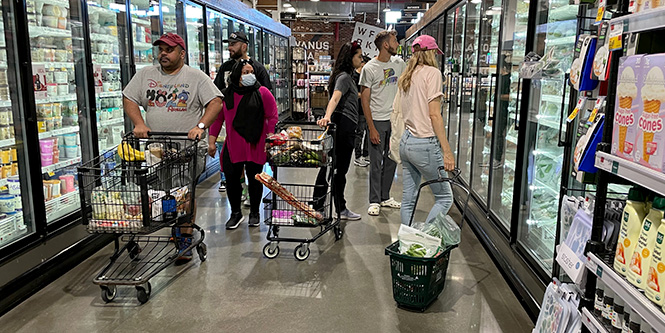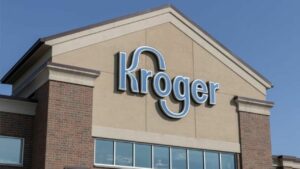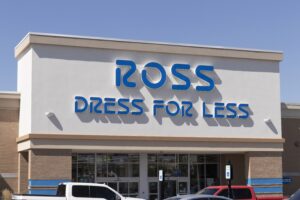
Photo: RetailWire
October 5, 2022
Do grocers have a price perception problem?
Food prices are rising, no doubt, but apparently American consumers think they are paying way more than price tracking statistics show is the reality.
New research from dunnhumby concludes that U.S. consumers believe that the food-at-home inflation rate has risen to 22.8 percent, nearly 10 percent higher than the 13.1 percent annual rate reported by the U.S. Bureau of Labor Statistics. The currently perceived rate is 5.1 percent higher than another dunnhumby “Consumer Pulse Report” released in February.
Americans told dunnhumby that they are hurting — 64 percent say they would have trouble covering an unexpected expense of $400. That’s up from 60 percent in April and May. Fifty-five percent say they are not able to get enough of the food they want and 18 percent report not having enough to eat. Thirty-one percent of households have reduced the sizes of meals or skipped them altogether over the last 12 months because of a lack of food.
Consumers’ concern with food costs is reflected in the finding that 37 percent are checking prices online before they shop. Thirty-five percent are buying in bulk to stretch their food dollars, and the same percentage are shopping multiple stores in search of the best deal.
The report indicates that food shoppers are trading down in a variety of ways to save money. Eighty-three percent say they are looking for cheaper alternatives in at least one category of products that they buy, with packaged goods (53 percent), household products (52 percent) and frozen foods (42 percent) topping the list.
Americans also appear to be shifting more of their food dollars away from specialty/premium stores to dollar chains. Dollar stores’ share of wallet has increased 2.1 percent since April/May and specialty/premium has dropped 1.1 percent. Shoppers have also cut back on online grocery, citing delivery and picking fees as a barrier to purchase.
Consumers are asking for consistency in pricing from food stores, with 59 percent reporting that they shop at stores with low base prices. Seventy-three percent of households with incomes above $100,000 cite low base prices as important.
“While there are signs in parts of the economy that inflation may be dampening, that has not occurred yet for food. Retailers and manufacturers need to ensure that they are putting their customers first when they are making decisions about how to respond to persistent inflationary cost pressures,” said Grant Steadman, president for North America at dunnhumby, in a statement.
Discussion Questions
DISCUSSION QUESTIONS: Does the grocery industry have a price perception problem? What actions, if any, can food retailers take now that will improve their customers’ perceptions of their businesses when inflation is less of a concern?
Poll
BrainTrust
Shikha Jain
Partner, Simon-Kucher & Partners
Brian Numainville
Principal, The Feedback Group
David Slavick
Co-Founder & Partner, Ascendant Loyalty
Recent Discussions







The price perception problem is unlikely to be consistent across all banners and so the tactics grocers use need to be customized to their retail value proposition. In the more premium players like Whole Foods, messaging quality, organic goods etc. can help justify the prices or use promotions on highly visible traffic-driving items. On the other end of the spectrum, players like Trader Joe’s and Aldi likely are benefiting and seeing consumers shifting their wallets to them. They can continue to message best price/best value in order to win during these times.
The official government inflation data are based on averages and a basket of products, so they don’t necessarily reflect the reality of all consumers. From our price tracking data there are some grocery items and products that have risen by as much as 38 percent. Those sharp increases can skew consumer perceptions, especially if they are on known value items. However I am not entirely sure that consumers blame food retailers for the price increases; I would think more of the blame is being pinned on government. As to what retailers can do: highlighting low price offers, keeping the prices of staple items as low as possible, and giving consumers trade-down options are all pieces of the jigsaw of helping consumers manage inflation.
It is not surprising that there is a price perception problem. Does a day go by that we do not hear about inflation? There is also a problem in understanding what the numbers mean. How many people will complain “prices were up 8 percent this month and 7 percent last month. That is 15 percent.” If inflation runs at the same rate month after month, there is no inflation increase after the first month. Sadly, the media does not explain this.
And the rates are annualized, which compounds the problem. Of course ignorance works the other way too: people confuse “inflation” (the rate of change in prices) with “prices” and think “oh, if inflation goes back to what it was in 2020, the prices will be what they were in 2020.” No they won’t.
I don’t know about the 7 or 8 or 15 percent calculation you guys are coming up with there, but let’s just look at this:
The United States SNAP (food stamp) program is re-measured every Federal fiscal year (October 1 starts the new Federal fiscal year). For SNAP, that government agency does a tracking of food inflation each year through July in order to determine how much to increase SNAP benefits by on October 1. At October 1, 2022, the SNAP benefits received an increase of 12.5%. That implies an increase in food prices through July 2022 of 12.5% based on the US Government’s tracking.
The unfortunate thing is prices increased again in August, but I did start to see increases level off in September.
But wait, there is more: in October 2021, SNAP benefits increased about 25% from pre-pandemic levels. This increase was based not only on inflation, but also on re-analyzing the program for “nutrition standards.” So this implies that inflation has been significantly higher on fresh/nutritious foods for a number of years now.
Exactly!
There is not only a price perception problem, there is also a profit perception problem. Our recent research shows that from the money shoppers spend at their primary supermarket, after paying expenses and taxes, shoppers think retailers make a 33 percent net profit (and, of course, reality is 1 percent to 3 percent based on FMI figures). So there is an issue with how much shoppers think they are paying AND how much they think retailers are making. Retailers need to do everything possible to convey what they are doing to make things better for their shoppers in this environment.
What I find interesting is a retailer with very high prices, at the end of the day, comes out to that same 1-3% profitability as a competing retailer with significantly lower pricing for the same exact items. In this specifically I am going to say Albertsons/Safeway vs. Kroger. You have two chains basically selling the same products, in the same format stores, both with largely Unionized workforces (paying similar/same wages in many markets), yet there is a major price gap between the everyday prices at these two chains.
This is a very interesting question! We’ve heard in recent months that Walmart and dollar/discount stores have seen an influx of higher-income shoppers, and that’s precisely because of price perception. Overall, I’d say this misalignment between shopper perception and reality is due to optionality these days – from the aforementioned stores to Aldi and Costco to loyalty programs such as Target Circle to the ability to price shop online, paying regular “full” price may seem high.
They do, because everyone keeps beating the drum on this issue.
The only drum beating is the cash register. Prices for many items are 30% higher than they were a year ago. Some Walmart and Dollar General stores are sloppy and just put new price tags in front of or on top of old price tags and you can look at the progression of prices on the items and see that in the past year most items have gone through 3 price increases of roughly 10% each time. Whatever is driving these price increases, be it the retailer, the CPG, or whatever, at the end of the day, the customer knows their $100 is not getting them even close to as many groceries as it did a year ago. This is no secret, the prices are numbers, it is very measurable.
There are some categories where prices haven’t increased but it is getting harder and harder to find those.
Anytime there is a noticeable price increase (in almost any industry) you will hear customers/consumers comment, question, and/or complain. Just the other day I noticed a sign apologizing for the increase in prices. Sometimes an explanation works, if made properly.
I agree. I had the checkout staff apologize to me for the prices at our favorite Jewel/Osco here in Chicago. That was a first!
Putting the customer first in any category is central to success. Offering a strong price/value to shoppers follows closely behind. The “new” behaviors are nothing new. Shoppers enabled by digital access have been “pre-shopping” for years. Sensitivity is way up and you see it every day in the grocery store as shoppers show signs of real stress as they walk the store and see prices that are much higher than they’ve ever experienced. Poultry, meat, baked goods, and fish are all 15 percent to 20 percent more expensive than they were 12 months ago. Big box shopping clubs and buying in bulk will continue to grow in market share while traditional grocers struggle to balance the gap between higher gross sales and even higher overhead/operating costs driven by logistics, salary and energy.
The stats on customer perceptions of higher price increases and retailer profits convey a sense of frustration among customers that they feel alone in their struggle.
While focusing on pricing is an obvious priority, this is also a time to focus on connecting emotionally with customers. Retailers can be vocal about their recognition of the challenges facing their customers and convey a “we’re in this together” message with tangible actions to back it up.
The effort to share the short term pain and strengthen the emotional connection with customers will pay off with more long-term customer loyalty.
Groceries are different than most items — except for things like gas and utilities which, not coincidentally, also have perception problems — in that people are exposed to a wide number of items, almost continuously; so every increase is picked up immediately.
As the numbers indicate, these numbers are also misrepresented, as people fixate on what went up and (over) extrapolate the results to everything (else). Should stores try to correct these mis-perceptions? I’m skeptical: any effort is likely to come across as patronizing (and of course the reality — only 13% — isn’t likely to calm anyone down).
Yes. Absolutely.
The worst pricing is the Safeway/Albertsons chain and its various banners. For its size, its pricing is outrageous in most markets. Kroger has been stronger on pricing (though this varies somewhat by market and they do tend to be closer to the Safeway type of pricing in CA/OR/WA) but isn’t as strong as it once was when comparing their prices to Walmart, Aldi, etc.
What I am seeing that is interesting or maybe not interesting is more and more shoppers at places like WinCo, Grocery Outlet, etc. Customers are starting to branch out and explore many other grocery options. And price isn’t the only reason. Mix is another reason. Going to a different store and getting exposed to a different mix of products also attracts customer interest. Not all stores sell the same things. Price may be one factor that motivates customers to branch out for the first time to other stores for food, but I think there are other factors that encourage them to keep branching out after the first time.
I don’t think the Dollar General/Family Dollar/Dollar Tree type stores are really going to take much grocery share given their mix, but if you start looking at categories like drug, paper products, cleaning supplies where they will absolutely take some sales that may have otherwise gone to grocers.